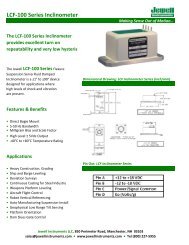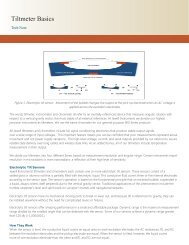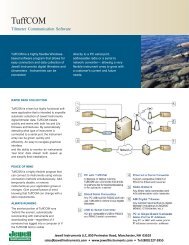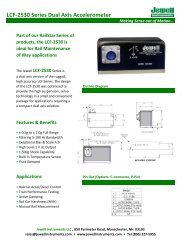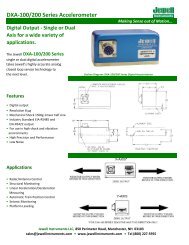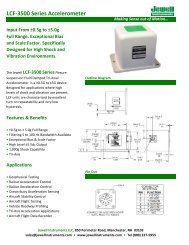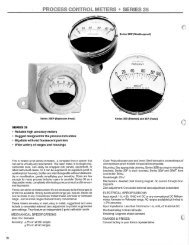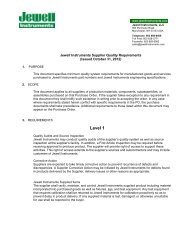Sensors Catalog - Jewell Instruments
Sensors Catalog - Jewell Instruments
Sensors Catalog - Jewell Instruments
Create successful ePaper yourself
Turn your PDF publications into a flip-book with our unique Google optimized e-Paper software.
Understanding the Specifications<br />
Input Voltage<br />
The input voltage specified is the range of voltages over<br />
which the unit is expected to operate within specification. If<br />
the input voltage is increased beyond the specified range, an<br />
accelerometer or inclinometer will continue to operate. At<br />
higher input voltages, additional current is required. The<br />
internal heat dissipation increases, and component life begins<br />
to decrease. Most units will also continue to operate at input<br />
voltages below the specified range. The output voltage<br />
clipping level and overrange capability are decreased at<br />
lower input voltages.<br />
Alternate input power choices including 5 volts,<br />
12 volts and 28 volts single ended as well as ±5 volts<br />
bipolar are available.<br />
Input Current<br />
The input current is the current the accelerometer or<br />
inclinometer will draw from a power supply at the specified<br />
nominal operating voltage. For bipolar input units, the<br />
positive and negative currents are not necessarily balanced.<br />
It is possible to reduce the current requirement, but<br />
applications must be evaluated on an individual basis.<br />
Output Impedance<br />
The standard output configuration is an operational<br />
amplifier with 100 ohms in series with the output. Other<br />
configurations including direct output across the load<br />
resistor, or use of an external load resistor, are possible.<br />
Operating Temperature Range<br />
The operating temperature range defines the temperature<br />
extremes over which the accelerometer or inclinometer<br />
will work without temperature induced failure or a permanent<br />
change in some output characteristic. A unit will<br />
continue to operate at temperatures somewhat higher<br />
or lower than stated in the standard specifications, but<br />
damage is likely.<br />
Survival Temperature Range<br />
The survival temperature range defines the temperature<br />
extremes a unit can be exposed to without damage when it is<br />
not powered.<br />
Shock and Vibration<br />
Shock indicates the highest shock level that the accelerometer<br />
or inclinometer can be exposed to without damaging<br />
the unit. The specified shock cannot be applied an infinite<br />
number of times.<br />
Random vibration limits are specified for 3-hour<br />
exposure to white noise in the bandwidth 20Hz to 2000Hz.<br />
The highest continuous acceleration level that can be<br />
applied without damage is typically 30g, but must be<br />
evaluated on an individual application basis if constant<br />
acceleration greater than 10g is present.<br />
Seal<br />
Sealing specifies the design technique selected to prevent<br />
moisture, dust, or other external contaminant from entering<br />
the sensor housing.<br />
11



